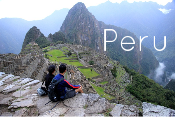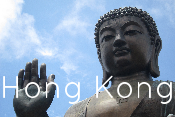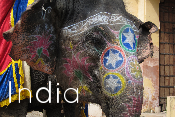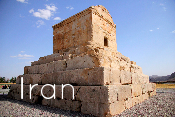When Eaman and I saw each other at the end of our 10-day meditation retreat, we were so eager to tell each other everything. We had been separated (by gender) and had taken a vow of silence, so, to finally be able to spill the beans was a pretty big deal. I let him tell me everything first and then I told him all about life on the other side of the center. And truly, we could not have had more different experiences. Seeing as how they were so different, we thought it made more sense to each tell you about our own experiences. But first, a little background. I’m going to go ahead and assume the questions people will ask us about the course because they’re probably the same questions we had about it ourselves.
I couldn’t really take pictures and didn’t even have my camera, but this photo of the pagoda at our center, called Dhamma Sota, will give you an idea.
What is Vipassana?
Vipassana is a meditation technique with roots in Buddhism that dates back about 2500 years. The goal of this technique is “to see things as they really are.” It involves inspecting the connection between the mind and the body to remove mental impurities with the goal of attaining happiness, a.k.a. liberation. Contrary to what a lot of people think, it’s not about focusing on an image or word or sound to relax; it involves a lot more work that has you zeroing in on the subtle sensations throughout your body. For a more detailed explanation, check out Dhamma’s description.
Why did you do it?
We wanted the Asian chapter of our travels to be less about hiking or socializing with hostel friends and more about focusing on ourselves, both as a couple and as individuals. We looked into both meditation and yoga retreats, but in the end the meditation seemed more challenging and different from anything we had ever done. Plus, the yoga retreats we found were expensive, and we had a hard time navigating among the hundreds of retreats out there.
How did you hear about it?
The other reason we knew we wanted to do a meditation course was because we had a solid recommendation from someone we trust. Pratt (from Hawaii fame), who also happens to be a yoga teacher, has done two Vipassana courses through Dhamma and spoke so highly of it, and since she’s one of our life role models, we said, If she did it, we should do it.
Is it religious?
Despite roots in Buddhism — Vipassana was reportedly founded by Gautama Buddha — Vipassana is non-sectarian.
Why India?
Vipassana flourished in Myanmar thanks to S.N. Goenka, but India is where it all started! Also, we thought the meditation would be a nice reprieve from crazy India. (And it was.)
What was the daily schedule?
Extremely well-planned out in our opinion. Even though we woke up at 4 a.m. and were meditating nearly 10 hours a day, it wasn’t exhausting.
4 a.m. Wake-up bell
4:30 – 6:30 a.m. Group meditation
6:30 – 7 a.m. Breakfast
7 – 8 a.m. Rest/shower
8 – 9 a.m. Group meditation
9 – 11 a.m. Meditation in hall, personal quarters or cell, according to teacher’s instruction
11 – 11:30 a.m. Lunch
11:30 a.m. – 1 p.m. Rest
1 – 2:30 p.m. Meditation in hall, personal personal quarters or cell, according to teacher’s instruction
2:30 – 3:30 p.m. Group meditation
3:30 – 5 p.m. Meditation in hall, personal quarters or cell, according to teacher’s instruction
5 – 5:30 p.m. Snack/tea break
5:30 – 6 p.m. Rest
6 – 7 p.m. Group meditation
7:15 – 8:15 Watch a video discourse by S.N. Goenka (there was an English version in another room)
8:30 – 9 p.m. Group meditation
9:30 p.m. Lights out
What’s with the silence?
It’s called “Noble Silence” and involves zero talking, body language and even eye contact. The only talking you’d do is to a teacher or assistant teacher if you have any questions or concerns. It makes sense considering this is a very personal journey and talking would likely have you comparing your experience to everyone else’s. (But some other student did make it a point to verbalize how bad it was for me to crack my knuckles. Forget the noises of all the bodily functions in the room; Archana’s knuckles are the problem!)
Did they let you take breaks?
I went into it thinking they’d be really strict, but so many people stepped out to go to the bathroom, stretch their legs or get water. The idea is: Don’t go for too long but do what you need to do.
How painful was it?
Very. Of course it gets better as you go, but at times I found the pain excruciating. Eaman fared better in terms of sitting for long hours. More on that below. Props to the old ladies and men who sat like rock stars.
Two meals a day. Yikes. How was the food?
Delicious! Sure, it was a little repetitive, but it was healthy vegetarian Indian food and exactly what we needed to clean out our systems after a year of junk eating. You may be surprised to hear that we were rarely hungry. (That tea break was a more substantial meal than I expected.) Plus, food was served buffet-style, so you could technically take as much as you want. That said, it’s not super comfortable to sit meditating with a full stomach.
What was the setting? Peaceful or prison-like?
The center was located about one hour outside New Delhi near the town of Gurgaon and very removed from most signs of life. We were separated by gender — though I would see Eaman in the meditation hall and during the evening discourse — and the rooms were clean, comfortable, with a fan and electricity most of the time. (No hot water though.) The actual grounds were like a forest meets botanical garden meets zoo, thanks to some peacocks, monkeys, frogs, weird birds and crazy insects that reside there. Watching them was a great way to unwind after those long meditation sittings. The less peaceful part was the barbed wire atop the brick wall that separated us from the rest of the world and the shards of glass in between the first layer of wire and the top of the brick. Not so zen.
Were there any Indian locals there?
Actually, it was mostly Indian locals. There were only about a dozen foreigners, representing Japan, Russia, Italy, Israel and the Netherlands among other places, within the 125-person mix.
How much does it cost?
It’s a donation-based program with the philosophy that a prior student’s donation makes your stay possible.
What did you get out of it?
That answer is a bit complicated. See below.
In His Words.
Two vegetarian meals a day and waking up at 4 a.m. The old me would say that’s a no-go. But I wanted to look past that and do something good (a.k.a. challenging) for myself. As far as the silence, not talking was easy for the first six or seven days, but after that, my mind was like someone with ADD changing the channels on a satellite TV every second. (It’s a good thing silence is broken on the morning of the 10th day and we had a day to re-acclimate because I was dying to get my thoughts out!) But the physical element of sitting nine+ hours a day was definitely physically grueling, especially with my prior knee problems and a dislocated shoulder.
The teacher had said that midway through the course, some issues — metaphysically called sankaras — may bubble up when we meditate and on day six it happened to me. These were issues that were always in the back of my mind but ones I had never addressed directly. So just as he had warned us, day six was the toughest for me. I was angry and sad and consumed and I couldn’t focus. But each day after, it got easier. I had a lot of conversations with myself and also took notes from what the technique teaches you — that your negative emotions hurt you, not anyone else. Over the next few days, I resolved my issues, and it’s worth mentioning that I still feel at peace now.
You learn a lot about patience during Vipassana. During meditation, I felt people staring at me, even though we’re told not to look at anyone else. I got frustrated and annoyed, wondering why all these eyes were on me. After Noble Silence ended, I talked to a lot of the guys and realized they were just really curious about me, my background and what brought me to Vipassana. In fact, I thought I did an average job at the whole thing, but the guy who had sat behind me later said to me that I was the iron man. “You inspired me to sit still,” he said. That was a shocker. It showed me that I need to exercise patience so negative emotions don’t take over me. It made me realize that physical pain and frustration, along with all these sankaras, are really just in your mind and can be controlled. You realize the negativity has no home, and it leaves your system.
I’m the kind of person who’s laid back 99 percent of the time and can explode like a volcano — courtesy of a cheating taxi driver or pushy salesperson — one percent of the time. It can be easy to lose my balance and patience. Since leaving the center, I’ve already noticed a change. During lunch at a kebab shop in Delhi after meditation, we were served under-cooked chicken. I normally would’ve blown up — remember that bout of salmonella in Cusco, Peru? Yeah, I didn’t want that again — but I was calm, explained what happened and didn’t get angry. And when I sat back down, Archana and I both talked about how different my reaction was. We thought, Whoa, that’s a change.
But the whole experience wasn’t just about learning patience. I learned about adaptability, having been taken out of my comfort zone and being thrown into a setting that’s totally different from anything I’m used to. After day one, you accept that this is how it is and you can either have positive energy and make the most of it or anxiously wait for each day to pass. If your mind is strong, you can adapt to anything. That’s a good lesson for anything in life.
It also made me realize religion is more about you and less about rituals and ceremonies, as the technique emphasizes personal experience as opposed to blindly following dogma or theories. Going forward, I want to do everything in my life because it has meaning for me, not because I’m supposed to do it.
It’s only been a week and I’m sure I need to give it some time and continue to practice, so my goal is to meditate at least one hour a day and keep improving myself. I’ll let you know how it goes!
In Her Words.
I began the course as World’s Most Typical Vipassana Student. Day two was hard and day six was even harder, just like the teacher had said. Thoughts in my head were ricocheting like a pinball machine, just like the teacher had said. When he said to feel sensations, I thought, “What sensations?” just like the teacher had said would happen. It was all very typical. Then, I ended the course as World’s Worst Vipassana Student. When you start the course, you take five precepts and one of them is not to engage in killing. I killed some bugs in my room. Maybe that’s where it all went downhill.
I went into this experience, thinking, “Oh, this sounds different. I’ll try it.” I’m not sure that’s the right attitude to have with something like this. I now know that the more you put into it and the more seriously you take it, the more benefits you reap. The whole time I felt like an observer — perhaps that’s the journalist in me — and I never completely wove myself into the fabric of the course.
I was sad to be away from Eaman, which I know sounds clingy, but can you imagine, after one year of 24/7 together, we all of a sudden were separated and, to top it off, in this intimidating situation? I was also really nervous about sitting all day. Eaman had taken to meditation rather quickly in Laos, but I had not. And I was picked on consistently by one of the assistant teachers. (“Don’t braid your hair in the dining hall.” “Don’t touch me [when I tapped her shoulder]. You’re not supposed to touch me.” “Don’t move your seat without telling me.” Or my favorite: “Don’t take someone else’s meditation cushion. That’s very bad.” OK, mine had disappeared, lady, and I don’t love being spoken to like I’m a five-year-old.) I seriously felt like everything I was doing was wrong, and coupled with the fact that I wasn’t having much success with my focusing, I began to feel sullen, antsy and frustrated. By the end of day 7, I was completely and utterly checked out. It was like, You want me to concentrate? I’ll show you concentration! During group meditations, I’d go through old dance routines in my head or think about what recipes I want to learn from my mom when I go home. When we were allowed to meditate in our cells if we wanted, I’d go just so I could sit in there with my eyes open and lay on the ground or do yoga stretches. Like I said, Worst Vipassana Student Ever.
Don’t get me wrong. I didn’t hate it and I certainly don’t regret it because 1. the worst experiences are the ones I learn the most from and 2. I still walked away with some positive elements. I did have good meditation days, days when I could really focus on my breathing and practice all that was being taught to us. I had a few days when I could sit still and meditate for a full hour without changing position, which taught me a great deal about discipline. I grew to like the silence; it gave me a chance to evaluate this past year and also think about any latent issues that I had been bottling up. I loved the food, and being a creature of habit, I loved the routine and totally relished waking up early and falling asleep by 9:30 p.m. It felt good.
I also really loved the evening discourses. S.N. Goenka is a powerful speaker, and there was so much I took from these sessions. I learned about how we always remember the negative and rarely the positive, how meaningless rituals can be without any sincerity behind them, how personal experience should always be the deciding factor in whether you prescribe to something — meditation techniques or otherwise. He says that we shouldn’t learn from the videos because it’s just intellectual and that we should instead learn from our own experience, but even so, the discourses were wonderful food for thought.
I beat myself up about the meditation course quite a bit towards the end of the 10 days and immediately after. I kept grilling myself, “Why don’t you feel like these other people who’ve come out of the course with tears of joy?” “Why didn’t you make that same connection?” Everyone had told me this would be a huge, life-changing experience and I really didn’t feel like that. I know, that’s exactly how not to think, since the entire point of Noble Silence is to avoid comparison chatter.
And then I got real.
I participated in something so physically and mentally challenging, something that so few people even know about and I didn’t even leave early. I still had a lot of positive takeaways and am now armed with a skill that’ll always be in my back pocket. I’d hesitate to call Vipassana a life-changing experience because it can set up such high expectations, but I think everyone takes out of it what he/she chooses and you can still end up with useful building blocks. Remember, it’s not for everyone (not sure it was for me) but still a good experience. As I’ve learned many times this year, something that takes you out of your element, something that can make you want to cry, something that scares the crap out of you is always good for the mind, body and soul.


















“I want to do everything in my life because it has meaning for me, not because I’m supposed to do it.” – great takeaway eaman
this is something i’ve always wanted to do and i can’t wait to hear more about it in person.
Thanks Avni! You should try it out in boston or dc. We’ll talk more about it when i see you sooooon!!!